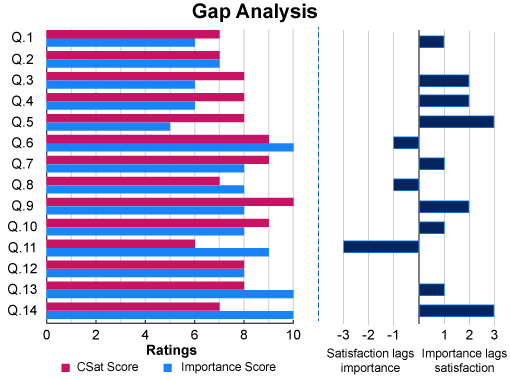We present five key ways of improving your Customer Satisfaction (CSat) score in the contact centre.
1. Run Gap Analysis to Identify Key Areas of Improvement
While almost every organisation measures CSat as a key advisor metric, far fewer measure and understand ‘importance’, and there’s a couple of downsides to avoiding this metric.
Firstly, it’s really difficult to try to prioritise areas for improvement, because just having an overall CSat score does not give you an understanding of which areas are the most important to improve, from a customer perspective.
Secondly, without measuring importance, you cannot overlay the two measures, which enables you to perform a Gap Analysis.
Gap Analysis breaks down your satisfaction and importance metrics across a number of different parts of your service, enabling you to identify where satisfaction lags importance and where satisfaction leads importance.
According to Richard Kimber, the Director at The Customer Experience Coach: “Gap Analysis breaks down your satisfaction and importance metrics across a number of different parts of your service, enabling you to identify where satisfaction lags importance and where satisfaction leads importance.”
“This gives you an idea of what you need to prioritise and address, as the areas in which satisfaction lags importance are those that need addressing quickly.”
To measure both these metrics in a way that enables you to perform Gap Analysis, you first need to create a list of attributes of your service.
These attributes will include things like “quickness in reaching an advisor”, “clear, knowledgeable advisors” and “first contact resolution”, as in the table below. A number between 10-20 of these attributes will be a good start.
Once you have this list, arrange focus groups and survey happy volunteers, asking them the following two questions for each attribute:
On a scale of one to ten, how important is this attribute to you? – This will allow you to create an average score for importance for each attribute.
On a scale of one to ten, how satisfied are you with this attribute of our service? – This will allow you to create an average score for satisfaction.
With these scores you can identify where satisfaction is lagging importance and by how much. This analysis will guide you on the areas in which you can make changes to provide the biggest boost to your overall satisfaction score.

Here is an example of a graph that a contact centre has put together to showcase the results of their gap analysis
| Attribute | |
|---|---|
| 1. | The usefulness of welcome mail |
| 2. | The usefulness of the user guide |
| 3. | Your introduction |
| 4. | The usefulness of the welcome mail |
| 5. | TMC answering any initial questions you had |
| 6. | The level of service provided by the customer service team |
| 7. | The helpfulness of the advisor that you last spoke to |
| 8. | The level of knowledge about your account |
| 9. | The professionalism of the customer service team |
| 10. | The friendliness of the customer service staff |
| 11. | The overall speed of response from customer services |
| 12. | The quality of outcome with your question or query |
| 13. | Customer services keeping promises and commitments |
| 14. | Customer services keep you informed |
Instead of Gap Analysis, you can instead run “Quadrant Analysis” to achieve similar results. To find out more, read our article: How to Get More From Your Customer Satisfaction (CSat) Scores
2. Identify Givens and Drivers of Satisfaction
Different aspects of your customer service have a different impact on your CSat score. In fact, they can often be broken down into two distinct categories; “givens” and “drivers” of satisfaction.
Givens are the basic elements of your service that can only be correct, i.e. they won’t drive satisfaction up, but – if they are not right – have the potential to drive it down.
Drivers, on the other hand, are elements of your service that have the potential to improve customer satisfaction, if developed in the right way.

Richard Kimber
Explaining the differential further, Richard says: “If I want to go out for a meal, I’m probably going to pick the restaurant based on the menu, price or referral. Invariably, we don’t tend to pick a restaurant based on the fact that the plates or toilets are clean.”
“But if those two things are not correct, I’m more likely to be dissatisfied. So, plates and toilets are what I would call ‘givens’.”
“Conversely, elements like price, friendliness and helpfulness of staff, they tend to be the aspects that really drive satisfaction.”
But what value will you get from categorising these influencers of satisfaction in this way?
Givens need addressing right away. They are not something that can be “developed”; they are either right or not right. These need urgent attention and to be corrected quickly.
Givens need addressing right away. They are not something that can be “developed”; they are either right or not right. These need urgent attention and to be corrected quickly.
Drivers are your key improvement areas for the future, so longer-term plans are needed to “grow” these aspects of your service, to continuously improve customer satisfaction.
If you have run a Gap Analysis, as in point 1, any “given” elements where satisfaction lags importance are your immediate priority. Plug the holes in your satisfaction score.
Once you have achieved this, move onto your drivers where satisfaction lags importance and create long-terms plans for how you can make widescale improvements to this aspect of your service.
3. Build Momentum Around Long-Term Plans
If you followed points 1 and 2, you’ll have been able to identify the areas in which you can drive satisfaction in the long term. To improve in these areas, you’ll create a plan, but to see those plans through and boost satisfaction, you’ll need momentum.
Building momentum into transformational plans is getting people to move beyond what they are doing today and into new routines, and that’s not really in our nature.
With this in mind, Morris Pentel, CEO at e-score.today, believes that you should start with a couple of small-scale changes when implementing long-term plans and look to gain momentum.

Morris Pentel
Morris says: “Starting is the hardest part, and you are going to need to break through that inertia. If transformational programmes don’t gather momentum, they will likely fail. So, start by designing a couple of small changes and look to nudge the right behaviours.”
“These small changes will help the team to develop habits, which is a proven starter. Using habits and nudges to help start this process should be a focus. Habits are part conscious and part unconscious so they are easy for each person to pick up and self-programme.”
Starting is the hardest part and you are going to need to break through that inertia. If transformational programmes don’t gather momentum, they will likely fail.
It is much easier to make small changes, which is why we often stick to methods of boosting CSat which are short-term strategies that only provide us with small changes to CSat. These include:
- Smiling while talking to create a positive tone of voice
- Removing jargon from scripts to sound more authentic
- Offering customer incentives
Yet, if we can approach big changes to further improve CSat as an accumulation of little changes, we can gain investment from the team around our longer-term plans – increasing the chance of their success. This starts with a couple of nudges to help build momentum and develop key habits.
For more short-term tips to boost CSat, read our article: 31 Quick-Fire Tips: How to Improve Customer Satisfaction
4. Proactively Communicate With Your Customers
In an increasingly commoditised world, organisations really have to investigate how they can differentiate themselves and how they can engage with customers to increase their satisfaction.
It’s got to be the right message, delivered at the right time, to the right people, and it has to be getting the right result.
This is according to Gerry Brown, Chief Customer Rescue Officer at The Customer Lifeguard, who says: “Connecting with customers on an individual basis is often the missing piece in the engagement puzzle.”
“It’s got to be the right message, delivered at the right time, to the right people, and it has to be getting the right result.”
So, the key to building customer satisfaction is to build rules into the customer journey for when a proactive message can add value and forge better relationships.
For example, if an online shopping basket has been created, but the customer is taking a long time to check out, a timely live chat pop-up can help you to offer that last-minute support that the customer needs. This may help to increase their satisfaction with their purchase.
Not only would a proactive message increase happiness in this instance, it may also prevent loss of business by decreasing your online shopping basket abandon rate.
Yet this isn’t the only way a proactive message could improve the customer journey. Using proactive messages in the following instances may also boost satisfaction:
- To alert a customer when their account is going below a minimum
- To alert a customer when prices for ongoing services are changing
- To alert a customer when their contract tie-in period is coming to a close
However, just a word of warning, while proactive messaging can be a great tool for increasing customer satisfaction, it could have a negative impact if implemented in the wrong way.
For example, if you don’t align your messaging with marketing or you could end up overwhelming the customer with communications, which might have a negative impact on their happiness.
To find more advice for creating the ideal proactive strategy, read our article: 7 Ideas for Proactive Customer Service
5. Define Your Culture by Your Customers, Refine It With Your People
Your customers will define what great service is and what satisfaction means to them. So it’s important that you create journeys and a culture that reflects the values that are most important to them.
This is why, when mapping customer journeys, organisations will survey their customers to find out which values mean the most to them. They will then develop promises and commitments from these values and ensure that they hit each of them at every stage of the customer journey.
Organisations will survey their customers to find out which values mean the most to them. They will then develop promises and commitments from these values and ensure that they hit each of them at every stage of the customer journey.
By journey mapping like this, you can improve satisfaction as you are developing a culture and an experience that is tailored to what matters most to your customers. Yet, according to Gerry Brown, defining a culture through means such as this is “only half the battle”.

Gerry Brown
Gerry says: “While going through these processes and choosing technologies to reflect customer values is important, humans can add empathy, creativity and passion to any interaction, so let your people refine your culture.”
“It is good to make use of these three skills within your contact centre team. Advisors who are trusted, treated well and empowered have the capability to make each experience memorable, regardless of complexity.”
This a great way to build a positive culture that will positively influence satisfaction, but we can also make the most of advisor creativity off the phone too, in order to refine our culture.
For example, if we can create listening mechanisms, we can create new processes and procedures that are based on customer values and advisor input. By combining the two, we can get advisors better invested in reaching outcomes that will benefit customers.
In Summary
The first three of these five methods offer great advice as to how you can identify key areas in which you can boost your CSat score, create a long-term plan and build momentum in turning that plan into a great success.
The other two points are based on two big industry trends; proactivity and culture. In these two areas, if treated carefully, organisations can also implement new strategies and create better experiences for their customers.
Good luck!
For more on measuring and improving CSat in the contact centre, read our articles:
- How to Calculate a Customer Satisfaction Score (CSAT)
- 15 Inventive Strategies to Increase Customer Satisfaction (CSAT)
- 9 Strategies to Improve Customer Satisfaction
Author: Robyn Coppell
Published On: 17th Apr 2019 - Last modified: 14th Aug 2025
Read more about - Customer Service Strategy, Communication Skills, Culture, Customer Experience (CX), Customer Satisfaction (CSAT), Editor's Picks, Gerry Brown, Metrics, Morris Pentel, Service Strategy, Team Management










































